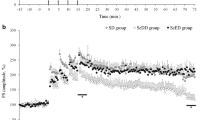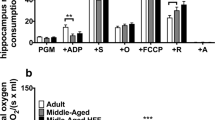Abstract
A reduction in taurine content accompanies the ageing process in many tissues. In fact, the decline of brain taurine levels has been associated with cognitive deficits whereas chronic administration of taurine seems to ameliorate age-related deficits such as memory acquisition and retention. In the present study, using rats of three age groups (young, adult and aged) we determined whether the content of taurine and other amino acids (glutamate, serine, glutamine, glycine, alanine and GABA) was altered during ageing in different brain areas (cerebellum, cortex and hippocampus) as well non-brain tissues (heart, kidney, liver and plasma). Moreover, using hippocampal slices we tested whether ageing affects synaptic function and plasticity. These parameters were also determined in aged rats fed with either taurine-devoid or taurine-supplemented diets. With age, we found heterogeneous changes in amino acid content depending on the amino acid type and the tissue. In the case of taurine, its content was reduced in the cerebellum of adult and aged rats, but it remained unchanged in the hippocampus, cortex, heart and liver. The synaptic response amplitude decreased in aged rats, although the late phase of long-term synaptic potentiation (late-LTP), a taurine-dependent process, was not altered. Our study highlights the stability of taurine content in the hippocampus during ageing regardless of whether taurine was present in the diet, which is consistent with the lack of changes detected in late-LTP. These results indicate that the beneficial effects of taurine supplementation might be independent of the replenishment of taurine stores.





Similar content being viewed by others
References
Arias N, Mendez M, Arias JL (2015) The importance of the context in the hippocampus and brain related areas throughout the performance of a fear conditioning task. Hippocampus. doi:10.1002/hipo.22430
Banay-Schwartz M, Lajtha A, Palkovits M (1989) Changes with aging in the levels of amino acids in rat CNS structural elements. II. Taurine and small neutral amino acids. Neurochem Res 14:563–570
Betz H, Laube B (2006) Glycine receptors: recent insights into their structural organization and functional diversity. J Neurochem 97:1600–1610
Csernansky JG, Bardgett ME, Sheline YI, Morris JC, Olney JW (1996) CSF excitatory amino acids and severity of illness in Alzheimer’s disease. Neurology 46:1715–1720
Dawson R Jr, Liu S, Eppler B, Patterson T (1999a) Effects of dietary taurine supplementation or deprivation in aged male Fischer 344 rats. Mech Ageing Dev 107:73–91
Dawson R Jr, Pelleymounter MA, Cullen MJ, Gollub M, Liu S (1999b) An age-related decline in striatal taurine is correlated with a loss of dopaminergic markers. Brain Res Bull 48:319–324
del Olmo N, Handler A, Alvarez L, Bustamante J, Martín del Río R, Solís JM (2003) Taurine-induced synaptic potentiation and the late phase of long-term potentiation are related mechanistically. Neuropharmacology 44:26–39
del Olmo N, Suárez LM, Orensanz LM, Suárez F, Bustamante J, Duarte JM, Martín del Río R, Solís JM (2004) Role of taurine uptake on the induction of long-term synaptic potentiation. Eur J Neurosci 19:1875–1886
Duarte JM, Do KQ, Gruetter R (2014) Longitudinal neurochemical modifications in the aging mouse brain measured in vivo by 1H magnetic resonance spectroscopy. Neurobiol Aging 35:1660–1668
El Idrissi A (2008) Taurine improves learning and retention in aged mice. Neurosci Lett 436:19–22
El Idrissi A, Boukarrou L, Splavnyk K, Zavyalova E, Meehan EF, L’Amoreaux W (2009) Functional implication of taurine in aging. Adv Exp Med Biol 643:199–206
El Idrissi A, Shen CH, L’Amoreaux WJ (2013) Neuroprotective role of taurine during aging. Amino Acids 45:735–750
Eppler B, Dawson R Jr (1998) The effects of aging on taurine content and biosynthesis in different strains of rats. Adv Exp Med Biol 442:55–61
Eppler B, Dawson R Jr (2001) Dietary taurine manipulations in aged male Fischer 344 rat tissue: taurine concentration, taurine biosynthesis, and oxidative markers. Biochem Pharmacol 62:29–39
Galarreta M, Bustamante J, Martín del Río R, Solís JM (1996) taurine induces a long-lasting increase of synaptic efficacy and axon excitability in the hippocampus. J Neurosci 16:92–102
Gold PE, Newman LA, Scavuzzo CJ, Korol DL (2013) Modulation of multiple memory systems: from neurotransmitters to metabolic substrates. Hippocampus 23:1053–1065
Heller-Stilb B, van Roeyen C, Rascher K, Hartwig HG, Huth A, Seeliger MW, Warskulat U, Häussinger D (2002) Disruption of the taurine transporter gene (taut)leads to retinal degeneration in mice. FASEB J 16:231–233
Hsu KS, Huang CC, Liang YC, Wu HM, Chen YL, Lo SW, Ho WC (2002) Alterations in the balance of protein kinase and phosphatase activities and age-related impairments of synaptic transmission and long-term potentiation. Hippocampus 12:787–802
Huxtable RJ (1992) Physiological actions of taurine. Physiol Rev 72:101–163
Ito T, Kimura Y, Uozumi Y, Takai M, Muraoka S, Matsuda T, Ueki K, Yoshiyama M, Ikawa M, Okabe M, Schaffer SW, Fujio Y, Azuma J (2008) Taurine depletion caused by knocking out the taurine transporter gene leads to cardiomyopathy with cardiac atrophy. J Mol Cell Cardiol 44:927–937
Ito K, Arko M, Kawaguchi T, Kuwahara M, Tsubone H (2009) The effect of subacute supplementation of taurine on spatial learning and memory. Exp Anim 58:175–180
Ito T, Yoshikawa N, Inui T, Miyazaki N, Schaffer SW, Azuma J (2014) Tissue depletion of taurine accelerates skeletal muscle senescence and leads to early death in mice. PLoS One 9:e107409
Kim HY, Kim HV, Yoon JH, Kang BR, Cho SM, Lee S, Kim JY, Kim JW, Cho Y, Woo J, Kim YS (2014) Taurine in drinking water recovers learning and memory in the adult APP/PS1 mouse model of Alzheimer´s disease. Sci Rep 4:7467
Liu QR, Lopez-Corcuera B, Nelson H, Mandiyan S, Nelson N (1992) Cloning and expression of a cDNA encoding the transporter of taurine and beta-alanine in mouse brain. Proc Natl Acad Sci USA 89:12145–12149
Manabe T, Wyllie DJ, Perkel DJ, Nicoll RA (1993) Modulation of synaptic transmission and long-term potentiation: effects on paired pulse facilitation and EPSC variance in the CA1 region of the hippocampus. J Neurophysiol 70:1451–1459
Miyazaki T, Matsuzaki Y (2014) Taurine and liver diseases: a focus on the heterogeneous protective properties of taurine. Amino Acids 46:101–110
Murakami T, Furuse M (2010) The impact of taurine- and beta-alanine-supplemented diets on behavioral and neurochemical parameters in mice: antidepressant versus anxiolytic-like effects. Amino Acids 39:427–434
Paban V, Fauvelle F, Alescio-Lauteir B (2010) Age-related changes in metabolic profiles of rat hippocampus and cortices. Eur J Neurosci 31:1063–1073
Paoletti P, Bellone C, Zhou Q (2013) NMDA receptor subunit diversity: impact on receptor properties, synaptic plasticity and disease. Nat Rev Neurosci 14:383–400
Parildar H, Dogru-Abbasoglu S, Mehmetcik G, Ozdemirler G, Kocak-Toker N, Uysal M (2008) Lipid peroxidation potential and antioxidants in the heart tissue of beta-alanine- or taurine-treated old rats. J Nutr Sci Vitaminol 54:61–65
Pierno S, De Luca A, Camerino C, Huxtable RJ, Camerino DC (1998) Chronic administration of taurine to aged rats improves the electrical and contractile properties of skeletal muscle fibers. J Pharmacol Exp Ther 286:1183–1190
Potier B, Turpin FR, Sinet PM, Rouaud E, Mothet JP, Videau C, Epelbaum J, Dutar P, Billard JM (2010) Contribution of the d-Serine-dependent pathway to the cellular mechanisms underlying cognitive aging. Front Aging Neurosci 2:1–11
Rosenzweig ES, Barnes CA (2003) Impact of aging on hippocampal function: plasticity, network dynamics, and cognition. Prog Neurobiol 69:143–179
Saransaari P, Oja SS (1997) Enhanced taurine release in cell-damaging conditions in the developing and ageing mouse hippocampus. Neuroscience 79:847–854
Schaffer SW, Ito T, Azuma J (2014) Clinical significance of taurine. Amino Acids 46:1–5
Strolin Benedetti M, Russo A, Marrari P, Dostert P (1991) Effects of aging on the content in sulfur-containing amino acids in rat brain. J Neural Transm Gen Sect 86:191–203
Suárez LM, Bustamante J, Orensanz LM, Martin del Río R, Solís JM (2014) Cooperation of taurine uptake and dopamine D1 receptor activation facilitates the induction of protein synthesis-dependent late LTP. Neuropharmacology 79:101–111
Sved DW, Godsey JL, Ledyard SL, Mahoney AP, Stetson PL, Ho S, Myers NR, Resnis P, Renwick AG (2007) Absorption, tissue distribution, metabolism and elimination of taurine given orally to rats. Amino Acid 32:459–466
Tinsley MR, Quinn JJ, Fanselow MS (2004) The role of muscarinic and nicotinic cholinergic neurotransmission in aversive conditioning: comparing pavlovian fear conditioning and inhibitory avoidance. Learn Mem 11:35–42
Zhang X, Liu H, Wu J, Liu M, Wang Y (2009) Metabonomic alterations in hippocampus, temporal and prefrontal cortex with age in rats. Neurochem Int 54:481–487
Zhang X, Wu J, Liu H (2013) Age- and gender-related metabonomic alterations in striatum and cerebellar cortex in rats. Brain Res 1507:28–34
Zhou Y, Holmseth S, Guo C, Hassel B, Höfner G, Huitfeldt HS, Wanner KT, Danbolt NC (2012) Deletion of the γ-aminobutyric acid transporter 2 (GAT2 and SLC6A13) gene in mice leads to changes in liver and brain taurine contents. J Biol Chem 287:35733–35746
Acknowledgments
This work was supported by a grant from “Instituto de Salud Carlos III” (PIU081067) to JMS. We thank Amparo Latorre and José Barbado for technical assistance. This article was revised by Proof-Reading-Service.com.
Author information
Authors and Affiliations
Corresponding author
Ethics declarations
Funding
This work was supported by a grant from “Instituto de Salud Carlos III” (PIU081067).
Conflict of interest
The authors declare that they have no conflict of interest.
Ethical approval
The care and use of animals was carried out following the European Communities Council Directive (86/609/ECC). Protocols were approved by “Comité Ético de Bienestar Animal” at Hospital Universitario Ramón y Cajal (animal facilities ES280790000092).
This article does not contain any studies with human participants performed by any of the authors.
Additional information
Handling Editor: M. Engelmann.
Rights and permissions
About this article
Cite this article
Suárez, L.M., Muñoz, MD., Martín del Río, R. et al. Taurine content in different brain structures during ageing: effect on hippocampal synaptic plasticity. Amino Acids 48, 1199–1208 (2016). https://doi.org/10.1007/s00726-015-2155-2
Received:
Accepted:
Published:
Issue Date:
DOI: https://doi.org/10.1007/s00726-015-2155-2




